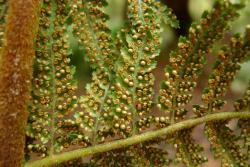- = Balantium Kaulf., Enum. Filic. 228 (1824)
Terrestrial ferns. Rhizomes long-creeping, or erect and forming a tall woody trunk, bearing multicellular hairs and buttressed by adventitious roots. Rhizome scales absent. Fronds monomorphic, or dimorphic with the fertile pinnae somewhat reduced. Stipes hairy. Laminae 2-pinnate-pinnatisect to 3-pinnate-pinnatifid, coriaceous, bearing multicellular hairs. Sori ovate to round, borne on vein endings on the abaxial surfaces, at or near the margins of the lamina; paraphyses present as multicellular hairs; sori protected by a membranous inner indusium and a reflexed lamina lobe, together forming a bivalvate or cup-like structure. Spores trilete, granulate or with reticulate lobes surrounding depressed areolae.
| 1 | Plants with aerial trunks; hairs on underside of pinna midribs and costae uniformly distributed, never woolly | 2 |
| Plants lacking aerial trunks; hairs on underside of pinna midribs and costae in dense woolly patches at costa junctions | lanata subsp. lanata | |
| 2 | Trunks black, bearing aerial buds; stipe and rachis red- or purple-brown, rough; tertiary pinnae decurrent at base to form a continuous narrow wing along costae of secondary pinnae | squarrosa |
| Trunks brown, lacking aerial buds; stipe and rachis pale or yellow-brown, smooth; tertiary pinnae stalked or adnate, not forming a continuous wing along costae of secondary pinnae | 3 | |
| 3 | Trunks up to 600 mm diam., covered in adventitious roots; basal pair of primary pinnae less than 95 mm long; longest fertile tertiary pinnae adnate at base, divided < halfway to midrib; fine, pale brown hairs c. 1 mm long present on underside of pinna midribs and costae | fibrosa |
| Trunks up to 150 mm diam., covered in stipe bases; basal pair of primary pinnae > 100 mm long; longest fertile tertiary pinnae stalked or sessile, divided > halfway to midrib; fine pale brown hairs c. 1 mm long, and thick rigid red-brown hairs up to 2.5 mm long, both present on underside of pinna midribs and costae | lanata subsp.hispida |
A genus of 20–25 species distributed in Central and South America, south-east Asia, eastern Australia, New Zealand, and in the Pacific as far east as Samoa; two species in tropical America, two on Juan Fernández Islands, one on St Helena, at least seven in south-east Asia, three in Australia and five in the western Pacific (Large & Braggins 2004b; Noben & Lehnert 2013). Three endemic species in New Zealand.
| Category | Number |
|---|---|
| Indigenous (Endemic) | 3 |
| Total | 3 |
The base chromosome number in Dicksonia is n = 65 (Kramer 1990).




